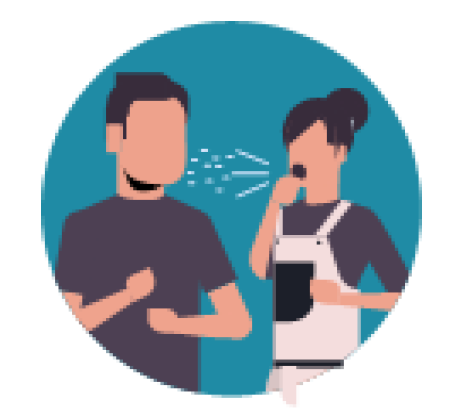Strategies to Control the Spread of COVID at Seafood Processing Plants: Employee Health
ID
FST-379NP
Employee Health: At Work or Returning to Work after Exposure
To ensure continuity of operations of essential functions, CDC advises that critical infrastructure workers (essential workers) may be permitted to continue work following potential exposure to COVID-19, provided they remain asymptomatic, have not had a positive test result for COVID-19, and additional precautions are implemented to protect them and the community.
Steps for employers
Screen all employees for fever before entering to work: Check temperatures of workers and assess symptoms at the start of each shift to identify anyone with a fever of 100.4℉ or greater. Do not let employees enter the workplace if they have a fever of 100.4°F or greater.
Regular Monitoring: As long as the employee doesn’t have a temperature or symptoms, they should self-monitor under the supervision of their employer’s occupational health program.
Wear a Mask: The employee should wear a face mask at all times while in the workplace for 14 days after last exposure.
Social Distance: The employee should maintain 6 feet and practice social distancing as work duties permit in the workplace.
Disinfect and clean work spaces: Clean and disinfect all shared areas and shared electronic equipment routinely.
Establish and maintain engineering controls and administrative controls.
Develop a contingency plan for situations that may arise as a result of outbreaks.

Steps for workers
Do
- Take your temperature before work.
- Wear a face mask at all times.
- Practice social distancing in the workplace as work duties permit.
- Follow health and personal hygiene practices
Don’t
- Stay at work if you become sick.
- Share headsets or objects used near face.
- Congregate in the break room or other crowdedplaces.
Know about COVID-19

Coronavirus (COVID-19) is an illness caused by a virus that can spread from person to person.
The virus that causes COVID-19 is a new coronavirus that has spread throughout the world.
COVID-19 symptoms can range from mild (or no symptoms) to severe and may include fever, cough, and shortness of breath.
Know how COVID-19 is spread

- Between people who are in close contact withone another (about 6 feet).
- Through respiratory droplets such as coughs,sneezes or talks
- Droplets can land in the mouths or noses ofpeople who are nearby or inhaled into the lungs.
Agricultural Employer Checklist for Creating a COVID-19 Assessment and Control Plan
Employers can use this checklist to create a COVID-19 assessment and control plan for applying specific preparation, prevention, and management measures.
This checklist can be modified to your needs and includes:
Section 1: Assessment
Section 2: Control Plan based on the Hierarchy of Controls
Screening and Monitoring Workers
Managing Sick Workers
Addressing Return to Work after Worker Exposure to COVID-19
Engineering Controls
Cleaning, Disinfection, and Sanitation
Administrative Controls
Personal Protective Equipment (PPE)
Section 3: Special Considerations for Shared Housing
Section 4: Special Considerations for Shared Transportation
Section 5: Special Considerations for Children
Additional Resources
CDC. 2020. Implementing Safety Practices forCritical Infrastructure Workers Who May Have Had Exposure to a Person with Suspected or ConfirmedCOVID-19. Interim guidance.
https://www.cdc.gov/coronavirus/2019-ncov/community/critical-workers/implementing-safety-practices.html
CDC 2020. Interim Guidance for Businesses andEmployers Responding to Coronavirus Disease 2019 (COVID-19).https://www.cdc.gov/coronavirus/2019-ncov/community/guidance-business-response.html
CDC 2020. Protecting Seafood Processing Workersfrom COVID-19. Interim Guidance from CDC and the Occupational Safety and Health Administration (OSHA). Developed in consultation with the Foodand Drug Administration (FDA).https://www.cdc.gov/coronavirus/2019-ncov/community/guidance-seafood-processing.html
Virginia Cooperative Extension materials are available for public use, reprint, or citation without further permission, provided the use includes credit to the author and to Virginia Cooperative Extension, Virginia Tech, and Virginia State University.
Virginia Cooperative Extension is a partnership of Virginia Tech, Virginia State University, the U.S. Department of Agriculture, and local governments. Its programs and employment are open to all, regardless of age, color, disability, sex (including pregnancy), gender, gender identity, gender expression, genetic information, ethnicity or national origin, political affiliation, race, religion, sexual orientation, or military status, or any other basis protected by law.
Publication Date
July 17, 2020



